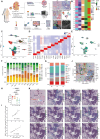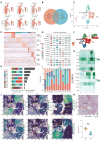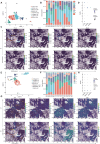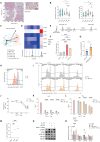Spatial and single-cell transcriptomics reveal cellular heterogeneity and a novel cancer-promoting Treg cell subset in human clear-cell renal cell carcinoma
- PMID: 39755578
- PMCID: PMC11748785
- DOI: 10.1136/jitc-2024-010183
Spatial and single-cell transcriptomics reveal cellular heterogeneity and a novel cancer-promoting Treg cell subset in human clear-cell renal cell carcinoma
Abstract
Background: Clear cell renal cell carcinoma (ccRCC) is the most common histologic type of RCC. However, the spatial and functional heterogeneity of immunosuppressive cells and the mechanisms by which their interactions promote immunosuppression in the ccRCC have not been thoroughly investigated.
Methods: To further investigate the cellular and regional heterogeneity of ccRCC, we analyzed single-cell and spatial transcriptome RNA sequencing data from four patients, which were obtained from samples from multiple regions, including the tumor core, tumor-normal interface, and distal normal tissue. On the basis, the findings were investigated in vitro using tissue and blood samples from 15 patients with ccRCC and validated in the broader samples on tissue microarrays.
Results: In this study, we revealed previously unreported subsets of both stromal and immune cells, as well as mapped their spatial location at finer resolution. In addition, we validated the clusters of tumor cells after removing batch effects according to six characterized gene sets, including epithelial-mesenchymal transitionhigh clusters, metastatic clusters and proximal tubulehigh clusters. Importantly, we identified a special regulatory T (Treg) cell subpopulation that has the molecular characteristics of terminal effector Treg cells but expresses multiple cytokines, such as interleukin (IL)-1β and IL-18. This group of Treg cells has stronger immunosuppressive function and was associated with a worse prognosis in ccRCC cohorts. They were colocalized with MRC1 + FOLR2 + tumor-associated macrophages (TAMs) at the tumor-normal interface to form a positive feedback loop, maintaining a synergistic procarcinogenic effect. In addition, we traced the origin of IL-1β+ Treg cells and revealed that IL-18 can induce the expression of IL-1β in Treg cells via the ERK/NF-κB pathway.
Conclusions: We demonstrated a novel cancer-promoting Treg cell subset and its interactions with MRC1 + FOLR2 +TAMs, which provides new insight into Treg cell heterogeneity and potential therapeutic targets for ccRCC.
Keywords: Immunosuppression; Immunotherapy; Kidney Cancer; T regulatory cell - Treg; Tumor Microenvironment.
© Author(s) (or their employer(s)) 2025. Re-use permitted under CC BY-NC. No commercial re-use. See rights and permissions. Published by BMJ Group.
Conflict of interest statement
Competing interests: None declared.
Figures







References
MeSH terms
LinkOut - more resources
Full Text Sources
Medical
Miscellaneous
